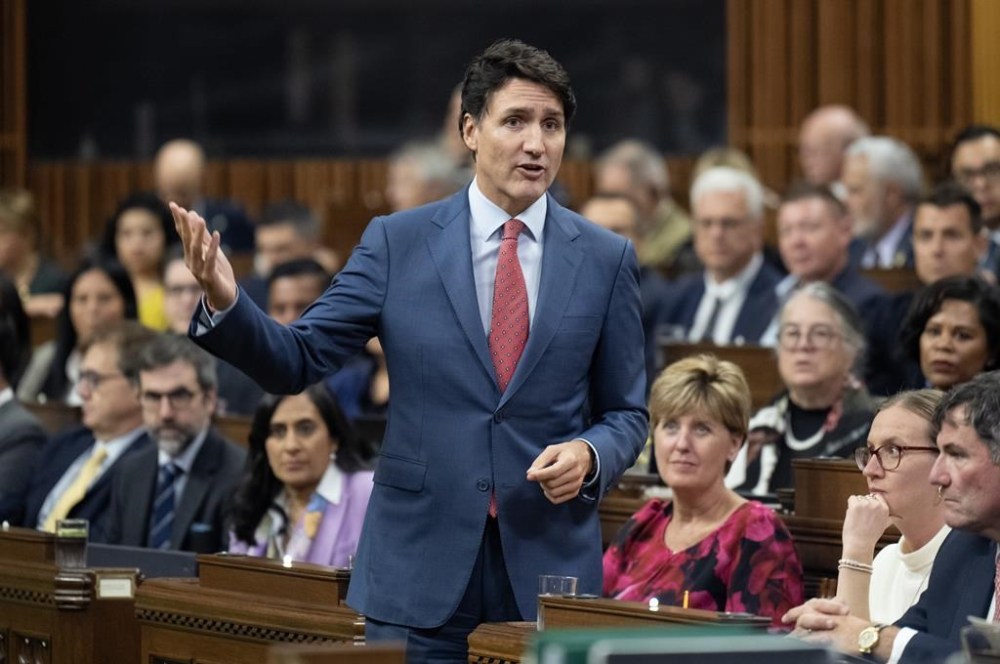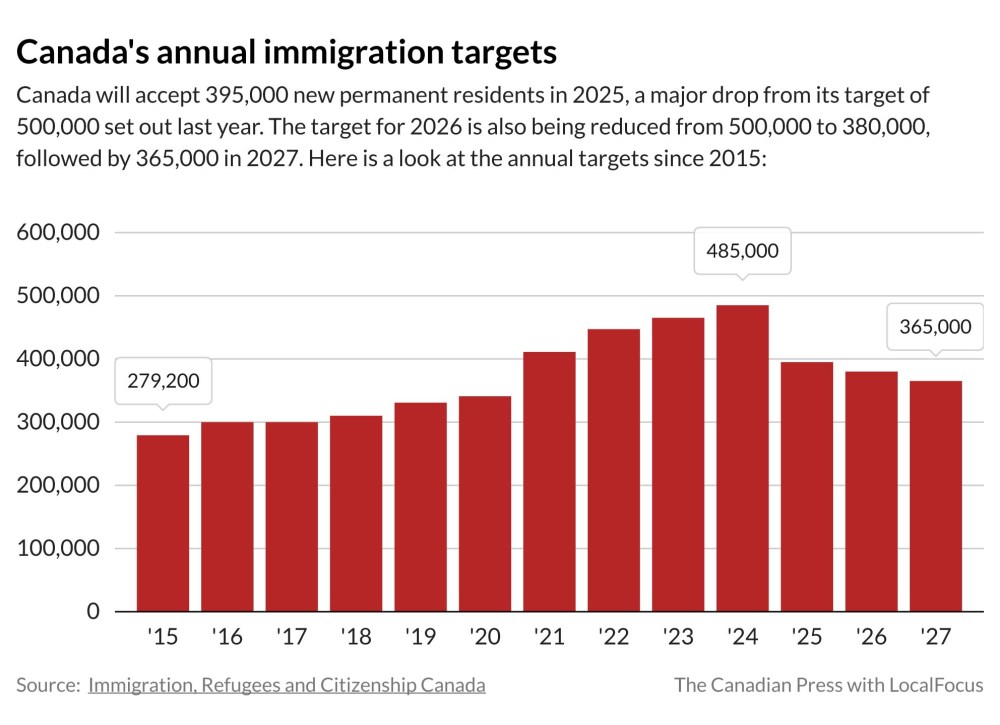Trudeau announces massive drop in immigration targets as Liberals make major pivot
Advertisement
Read this article for free:
or
Already have an account? Log in here »
To continue reading, please subscribe:
Monthly Digital Subscription
$0 for the first 4 weeks*
- Enjoy unlimited reading on winnipegfreepress.com
- Read the E-Edition, our digital replica newspaper
- Access News Break, our award-winning app
- Play interactive puzzles
*No charge for 4 weeks then price increases to the regular rate of $19.00 plus GST every four weeks. Offer available to new and qualified returning subscribers only. Cancel any time.
Monthly Digital Subscription
$4.75/week*
- Enjoy unlimited reading on winnipegfreepress.com
- Read the E-Edition, our digital replica newspaper
- Access News Break, our award-winning app
- Play interactive puzzles
*Billed as $19 plus GST every four weeks. Cancel any time.
To continue reading, please subscribe:
Add Free Press access to your Brandon Sun subscription for only an additional
$1 for the first 4 weeks*
*Your next subscription payment will increase by $1.00 and you will be charged $16.99 plus GST for four weeks. After four weeks, your payment will increase to $23.99 plus GST every four weeks.
Read unlimited articles for free today:
or
Already have an account? Log in here »
Hey there, time traveller!
This article was published 24/10/2024 (423 days ago), so information in it may no longer be current.
OTTAWA – The federal government slashed immigration targets to levels that will flatten population growth as Prime Minister Justin Trudeau admitted Thursday the government did not get the balance right after the COVID-19 pandemic.
The government had targeted bringing in 500,000 new permanent residents in both 2025 and 2026.
Next year’s target will instead be 395,000 new permanent residents, and that will fall to 380,000 in 2026 and 365,000 in 2027.

“In the tumultuous times as we emerged from the pandemic, between addressing labour needs and maintaining population growth, we didn’t get the balance quite right,” Trudeau said Thursday morning.
“With the plan we’re announcing today, along with previously announced measures, we’re making our immigration system work better.”
The change comes after significant criticism of the Liberal government’s increases to immigration and the impact of strong population growth on housing availability and affordability.
The federal government estimates Canada’s population will decline slightly by 0.2 per cent in 2025 and 2026, before returning to growth of 0.8 per cent in 2027.
Statistics Canada recently reported that the population on July 1 was a whopping three per cent higher than a year earlier. Between 1998 and 2018, annual population growth was less than 1.5 per cent.
The Canadian Press reported in January that internal documents obtained through an access-to-information request showed federal public servants warned the government two years ago that large increases to immigration could affect housing affordability and services.
But Trudeau said on Thursday that businesses and provinces have also been part of the reason why the immigration system got out of control.
“Far too many corporations have chosen to abuse our temporary measures, exploiting foreign workers while refusing to hire Canadians for a fair wage,” Trudeau said.
“All while under the watch of provinces, some colleges and universities are bringing in more international students than communities can accommodate, treating them as an expendable means to line their own pockets. That’s unacceptable, and it needs to change.”
Ottawa is also aiming to reduce the proportion of temporary residents — which includes temporary foreign workers and international students — to five per cent of the population over the next three years, down from 7.2 per cent in July.
The federal government says that means the non-permanent resident population will decrease by 445,901 in 2025, 445,662 in 2026 and will increase modestly by 17,439 in 2027.
Business groups reacted negatively to the news, arguing it will hurt the ability of employers to fill labour shortages.
The Canadian Chamber of Commerce said the plan is “disappointing for businesses across the country that, in recent months, have had to deal with abrupt and constant changes to immigration policy.”
“Significantly decreasing our labour pool will impact thousands of these employers across Canada struggling to find the workforce they need to operate and grow,” the chamber said in a statement.
The Canadian Federation for Independent Business said the “dramatic cut” to the targets will hurt businesses who, despite rising unemployment, are facing hundreds of thousands of job vacancies.
The Bank of Canada’s recent business outlook survey found labour shortages are now below the historical average.
The Liberals’ pivot on immigration follows a rapid increase to the number of new permanent residents in Canada and a ballooning number of people coming to the country on a temporary basis. Federal ministers have conceded that has put pressure on housing, health care and affordability.
NDP Leader Jagmeet Singh and Conservative Leader Pierre Poilievre both reacted by blaming Trudeau for ruining the immigration system in the first place.

“Trudeau’s last minute pre-election reversal cannot be believed. He can’t fix the immigration system that he broke,” Poilievre said.
Singh said Trudeau’s announcement is a “minor tweak of 20 per cent” and doesn’t address the “serious challenges” Canadians are facing when it comes to housing and health care.
Immigration Minister Marc Miller said the lower numbers will help with the housing shortage, estimating that by 2027, Canada will need to build 670,000 fewer homes to close the gap.
The federal government plans to prioritize temporary residents for permanent residency, expecting they will fill more than 40 per cent of the permanent residency spots.
“These people are a young labour pool. They’re skilled, they’re here,” Miller said.
“They’ve begun their process of integration and it doesn’t place the additional demands on the housing, health care and social services that we see with someone that comes directly from another country. It makes sense.”
The federal government is also increasing its francophone admission target for outside of Quebec to 10 per cent in 2027, up from six per cent this year.
In a new report published by BMO, senior economist Robert Kavcic writes that the plan will “take stress off the economy and infrastructure that has become almost debilitating in recent years.”
In addition to taking pressure off home prices and rents, Kavcic says the slowdown in population growth will also help reduce slack in the job market.
As high interest rates sent a chill through the economy, Canada’s unemployment rate climbed to 6.5 per cent in September, up a full percentage point from a year earlier.
Young people and newcomers have felt the brunt of the job market slowdown, facing significantly higher unemployment rates compared to other workers.
This report by The Canadian Press was first published Oct. 24, 2024.
— With files from Rosa Saba and David Baxter
Note to readers: This is a corrected story. A previous version stated that Statistics Canada reported that the population on July 1 was a 3.2 per cent higher than a year earlier.
History
Updated on Thursday, October 24, 2024 10:45 AM CDT: Adds graphic





